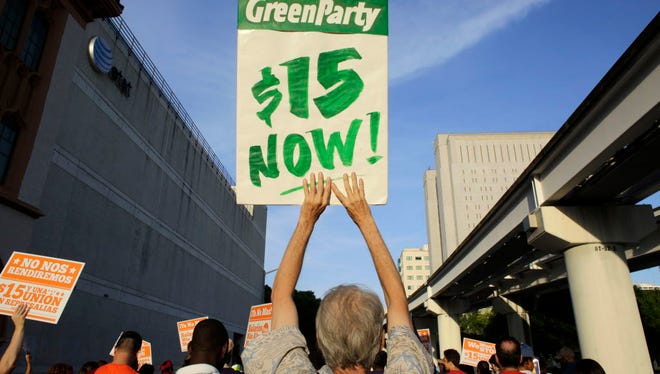Low-paid workers are leading in wage gains

Low-paid workers didn’t exactly declare their independence this past weekend but they did snag another round of minimum wage hikes as part of their years-long rebellion against languishing earnings.
An unusual flurry of minimum wage increases took effect Friday in Maryland and Oregon, as well as in 13 cities and counties, including Los Angeles, San Francisco, Chicago, Washington DC and Louisville, Ky., according to the conservative Employment Policies Institute and liberal National Employment Law Project. The initiatives will boost minimum pay to as much as $13 to $14.82 an hour in parts of California.
And the latest studies underscore that their efforts have been stunningly fruitful, with the pay of low-wage workers rising far more rapidly than their higher-earning counterparts. Meanwhile, employer advocates are taking an increasingly aggressive stance against the raises, running ads to argue they’re hurting businesses and jeopardizing summer job opportunities for teens.
Hear stories of people living on minimum wage
Kejioun Johnson, 20, who has worked at a McDonald’s (MCD) in Chicago the past year, has been earning the city’s minimum wage of $10 an hour, but typically puts in just 7 1/2 hours a week, often forcing him to skip meals. The extra 50 cents an hour he pocketed starting Friday “can be like an extra meal,” says Johnson, who also recently started a part-time job at Burger King.
Separately, workers at four of five Atlantic City casino hotels who threatened to strike Friday secured higher pay, and retained healthcare and pension benefits on the eve of the deadline. Workers at Trump Taj Mahal walked off the job.
Over the past two years, more than a dozen states and dozens of cities and counties have voted to gradually increase their pay floors through legislation or ballot initiatives. Advocates largely credit the Fight for $15 movement, which has spearheaded fast-food worker strikes across the country since 2012.
Nearly 30 states with 60% of the U.S. workforce now have minimum wages higher than the federal government’s $7.25 an hour, according to NELP. And after California and New York agreed early this year to boost their base pay to $15 an hour by 2022, joining cities such as Seattle and San Francisco, 20% of U.S. workers are in jurisdictions transitioning to that threshold, NELP says.
$15 minimum wage coming to New York, Calif.
“Now that the minimum wage increases are accelerating, we’re going to see much bigger gains at the bottom…that will start reversing decades of widening pay inequality,” says NELP General Counsel Paul Sonn.
A recent Goldman Sachs analysis of Labor Department data shows that workers in the bottom 10th percentile of hourly wages received the largest pay increases last year at about 2.8%, compared to about 2% for other income groups. And in the first quarter of 2016, workers in the bottom fourth of the pay scale notched annual average pay hikes of 4.2%, compared to 2.7% for median earners, according to a Moody’s Analytics review of Labor Department figures.
The bigger increases for low-wage workers partly reflect a tightening labor market that saw that group lag behind higher earners for years, but they mostly stem from the minimum wage hikes, says Moody’s Chief Economist Mark Zandi. Earnings gains for the 10th percentile of workers grew nearly twice as fast last year in states that passed minimum wage increases, an Economic Policy Institute study showed.
Does a $70,000 minimum wage work?
Many employers say there are drawbacks. The Employment Policies Institute, which is backed by the restaurant industry, ran a full-page ad in Thursday’s New York Times that said unions’ call for a $15 wage “will kill the job market for young people” as employers seek experienced workers. The group’s research director, Michael Saltsman, says sharp pay increases in California already have prompted some businesses to close or cut staff.
Michael and Susan Iida shuttered Mokka coffee house in Berkeley, Calif. last month because of minimum wage hikes from $8 to $11 an hour the past few years that cut profits about 65%, Michael says. Although the couple raised prices about 11% to offset the expense, that hurt traffic, leaving revenue roughly unchanged, he says.